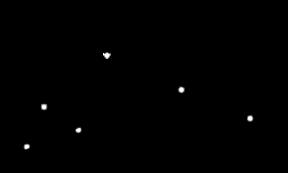
NavList:
A Community Devoted to the Preservation and Practice of Celestial Navigation and Other Methods of Traditional Wayfinding
From: Peter Fogg
Date: 2008 Aug 9, 18:59 +1000
Earlier I wrote:
"Imagine 2 sights that can sit on,
or very nearly on the slope and a third that is only off by a small extent.
A resolution of this dilemma that approximates averaging would be to put the line between the pair
and the single one, favouring the pair. And that could be the best
solution. With averaging its the only solution."
"On the other hand, maybe the 2 sights are good ones and the other indicates a greater extent of error. Such is the agonising that slope analysis can encourage! Its fairly evident that more sights are potentially helpful, although they can simply complicate things."
As long as those non-conformists cooperate by placing themselves at equal distances and on either side of the slope, then averaging will give a good result. This, after all, is the assumption behind averaging, that error can be averaged out to an improved result. But you can see that in practice it depends on the cooperation of chance. Not the best way to go, if there is a better alternative, perhaps …
Only one sight is different here, but what a difference it makes. Not only has the line moved significantly (indicating change in altitude/time), but an approximation of averaging (dotted line) has altered the slope that regression analysis would produce (another technique that gets confused with slope analysis). This dotted line is simply wrong, both in slope and position. Why would you prefer to use it? An averaged result would also contain significant error, assuming those two sights are good ones.
This, I contend once again, is why some form of averaging is inherently inferior; because it is based on an incorrect assumption. Averaging is potentially useful in some situations but not for this, where slope analysis tends to be superior.
"Its fairly evident that more sights are potentially helpful …"
Two sights that fit nicely on the slope, the actual slope of the body's apparent rise/fall, could be a coincidence, although the more points that approximate that slope the more unlikely coincidence becomes as an explanation. In this case the analysis is easy, and its not always this obvious. The position of the other sights becomes irrelevant, they are now effectively discarded. If they can't be fitted to the line then they, quite literally, have no place on it.
Without slope analysis you wouldn't know what the slope would be (what angle). Use of averaging or regression analysis would simply place you at the mercy of chance. You could even end up with an averaged result worse than just relying on a single random sight. Here that last sight, below the line, is again tending to balance out the others above, and averaging would give a reasonable result (although I suspect that regression analysis would provide the wrong slope). But what if that last sight was, like the other odd two, well to the top of this graph? An averaged result would simply provide significant error.
David Burch's PDF article provides other examples. But David Burch's list of references at the end has a curious omission, as it fails to mention George Bennett's "The Complete On-Board Celestial Navigator" which has been available in various editions since 1999 and has sold more than 5,000 copies worldwide (huge for books about navigation).
Bennett's book, in keeping with its intention of providing a complete, compact and very practical navigational toolkit ("Everything but the Sextant") includes: a graphical method (a nomogram) to simply and quickly determine slope, a form for plotting, and a worked example. Its how I learned about the technique. Don't put to sea without it.
--~--~---------~--~----~------------~-------~--~----~
Navigation List archive: www.fer3.com/arc
To post, email NavList@fer3.com
To , email NavList-@fer3.com
-~----------~----~----~----~------~----~------~--~---










